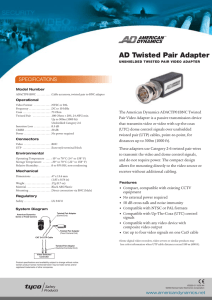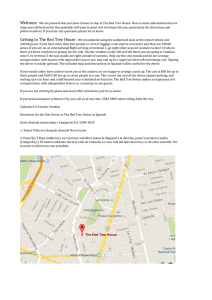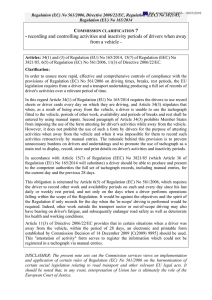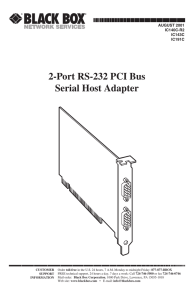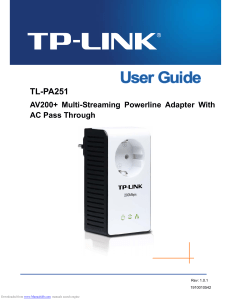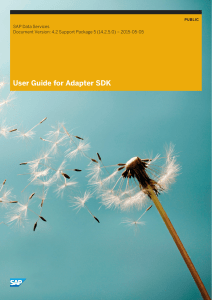Latest User Manual
Anuncio
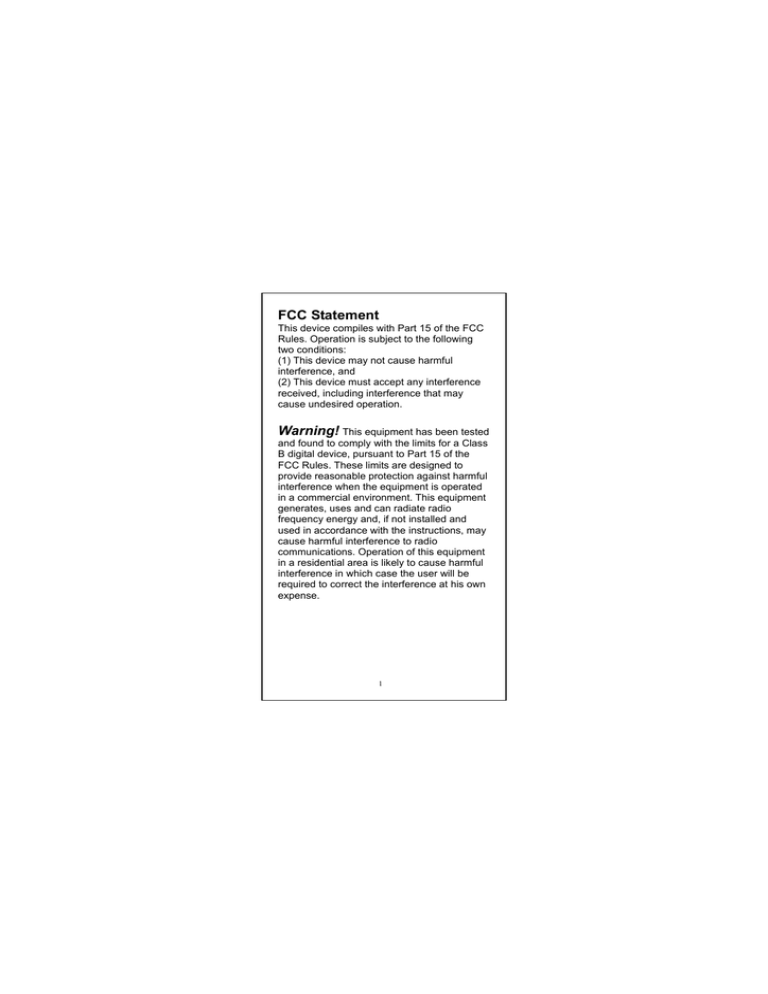
FCC Statement This device compiles with Part 15 of the FCC Rules. Operation is subject to the following two conditions: (1) This device may not cause harmful interference, and (2) This device must accept any interference received, including interference that may cause undesired operation. Warning! This equipment has been tested and found to comply with the limits for a Class B digital device, pursuant to Part 15 of the FCC Rules. These limits are designed to provide reasonable protection against harmful interference when the equipment is operated in a commercial environment. This equipment generates, uses and can radiate radio frequency energy and, if not installed and used in accordance with the instructions, may cause harmful interference to radio communications. Operation of this equipment in a residential area is likely to cause harmful interference in which case the user will be required to correct the interference at his own expense. 1 CE-Mark Warning In a domestic environment this product may cause radio interference in which case the user may be required to take adequate measures. Copyright © 2002, All right Reserved. Document Version: 2.0 All Trademarks and trade names are the properties of their respective owners. 2 1. Introduction Congratulations on the purchasing of your new 10/100 NWay Fast Ethernet PCI adapter. This document describes the Installation of network adapter. This adapter supports 10BASE-T/100BASE-TX Fast Ethernet and complies with the electrical and protocol requirements of the PCI Local Bus Specification, revision 2.2. 1.1 Features The 10/100 Fast Ethernet PCI adapter is a cost effective, high-performance network interface card. It operates in 10BASE-T and 100BASE-TX modes and integrates easily with Fast Ethernet hub and switch. y y y y y y IEEE 802.3 10BASE-T and 100BASE-TX standards 32-bit bus master for high throughput and low CPU utilization Full-duplex operation at both 10Mbps and 100Mbps Supports 10/100Mbps auto-sensing capability Single shield RJ-45 connector for using at either Speed (Category 3, 4 or 5 UTP cable for 10Mbps Operation, and Category 5 UTP cable for 100Mbps Operation) Plug and Play Installation. 3 y y Network drivers on the diskette for Windows 95, 98, ME, NT, 2000, XP, NetWare, Unix and Packet driver. FCC, CE certification 1.2 System Requirements To use the adapter, you need the following components: y A PCI master mode expansion slot that is compliant with PCI bus specifications, revisions 2.2 y A 3.5-inch,1.44MB diskette driver y The following cables: To operate at 10Mbps, a Category 3, 4, 5 UTP/STP Cable To operate at 100Mbps, a Category 5 UTP/STP cable 2. Installation This section describes how to install the adapter. For connecting to the network, you must have the following: 1. Network adapter card installed to your computer. 2. Software for the adapter card contains both configuration utilities and drivers 4 2.1 Unpack and Inspect Caution: Under ordinary circumstances, this adapter card will not be affected by static charge as may be received through your body during handling of the unit .In special circumstances where you may carry an extraordinarily high static charge, it had better reduce the charge by touching a ground before handling the adapter card. Open the shipping gift box and carefully remove all items. In addition to this User’s Manual, please check the following items: y One 10/100 Fast Ethernet PCI Adapter Card y One 3.5” Drivers and User’s manual diskette Note: If any of the listed items are missing, please contact your distributor or reseller 2.2 Install the Adapter 1. Turn off the computer. 2. Remove the computer’s cover, in accordance with its manual. 3. Insert the contact edge of the adapter card into the connector of any available PCI Bus master expansion slot. Press the card 5 firmly into the connector to PCI slot. Please make sure that the card’s contacts are fully seated in the PCI slot. 4. Install the bracket screw that secures the card to the Computer chassis. 5. Replace the computer’s cover. 6. Connect the CAT3 or CAT5 UTP cable to the RJ-45 network connector. 7. Remove [Drivers and User’s manual] diskette from the PC diskette drive. 8. Turn on the computer. 9. If the BIOS section of your computer’s boot program is Plug and Play compliant, then at power up the BIOS will configure any newly installed adapter automatically. Note: Due to some Plug-n-Play BIOS programs' problem, it happens occasionally that a newly installed adapter is assigned an Interrupt Number which is already used by another device adapter. In such a case, the conflict of Interrupt Number will cause faults in the behavior of both devices. Then it is necessary to run the CMOS Setup utility, and manually assign a non-conflict Interrupt Number. 6 2.3 Connect Fast Ethernet Category 5 UTP cable is required for Fast Ethernet operation. The maximum cable run between the adapter and the supporting hub is 300ft (100m). Make the network connection by plugging one end of the cable into the RJ-45 receptacle of the adapter, and the other end into one port in the hub. 2.4 Connect 10Mbps Ethernet Category 3, Category 4, and Category 5 UTP cable, as well as EIA/TIA 568 100 ohm STP cable, all qualification under Ethernet cabling rules. The maximum cable length run between this adapter and the supporting hub is 300 ft. Make the network connection by plugging one end of the cable into the RJ-45 receptacle of this adapter, and the other end into the hub. 7 2.5 Drivers and User’s manual Diskette The [Divers and User’s manual] diskette contains all the popular operating system drivers. y Novell NetWare(client /server) y Windows NT 3.5, NT4.0/2000/XP y Windows 95/98/ME y Microsoft Client (NDIS 2.0 DOS/OS2) y Windows For Workgroup 3.11 y …. and so on 2.6 Software Installation Please refer to “Quick Installation Guide” 8 2.7 Test Program This test program verifies configuration of the adapter and assists the isolation of any faults in operation. Test procedure are optional, and will only be useful in the unusual event that there is a fault, such as an interrupt number conflict among your computer’s add on cards, If your installation provides normal operation, you do not need these test procedures. At your DOS prompt, type the following command: a:\rset8139.exe <Enter> The opening screen is displayed as following: View Current Configuration Set Up New Configuration Run Diagnostics Exit RSET8139 Choose <Set Up New Configuration> item allows you to set up the Network Speed, 10 or 100M, and Transmission Mode, Full or Half Duplex, and so on. Choose <Run Diagnostics> item to run the adapter test program. Adapter test program includes: <Run EEPROM Test>, <Run Diagnostics on Board>, <Run Diagnostics on Network>, and <Run Power Management Test>. The <Power Management Test> is available for WOL adapter only. 9 After choosing the <Run Diagnostics on Board> item, the screen will display like, Node ID........: 00 e0 7d c0 00 01 Network Speed..: 100Mbps I/O Base ......: E000H Interrupt .....: 11 Full-Duplex ...: Disabled Pass Count Fail Count A. I/O Register B. 100Mbps Loopback C. 10Mbps Loopback D. Cable Connection <Cable Connection> test reminds you that the connection link might be fail, either the cable is not connected or the cable link fails. For the <Run Diagnostics on Network> test, it is necessary to connect your computer with its supporting hub or another computer. This is a "Ping-Pong" test. This test cannot be completed except two computers on the LAN for sending or receiving the test packets between computers. 10 11 For the <Run Diagnostics On Network> test Ethernet Address 00E07DC00002 Target Machine Ethernet Address 00E07DC00001 Master Machine Netwok Master Machine: Master machine sends magic packet or Wake up frame through the network. Target Machine: Target machine is notified whenever a qualified wakeup packet is received. 12 Quick Installation Guide Please take the following steps for driver installation. Microsoft Windows 95/98/ME 1. Turn off the computer. 2. Insert the adapter into the available PCI slot. 3. Restart the computer. 4. After Microsoft Windows reboot, the PCI Ethernet Controller will be found. 5. The system will prompt for driver installation. 6. Insert the “Driver and Utilities” diskette into diskette driver and press <Enter>. 7. For Windows 95, Key in a:\ path to install driver for the adapter 8. For Windows 98, Key in a:\w98_2000 path to install driver for the adapter 9. For Windows ME, Key in a:\winme path to install driver for the adapter 10. The Windows system will install the driver automatically. 11. Reboot the Windows system. 13 Windows NT 1. Turn off the computer. 2. Insert the adapter into the available PCI slot. 3. Restart the computer. 4. Click “Start” menu bar and select “Setting” item then “Control Panel” setting 5. Select “Network” icon 6. If this is the first time to install network on the machine then the system will ask “YES” or “NO” to install network adapter. Please select “YES” 7. If the computer already install network before then you need to select “Interface” -> “Add” 8. The system will prompt for driver installation. 9. Insert the “Driver and Utilities” diskette into diskette driver and press <Enter>. 10. Key in a:\winnt path to install driver for the adapter 11. The Windows system will install the driver automatically. 12. Reboot the Windows system. 14 Microsoft Windows 2000 1. Turn off the computer. 2. Insert the adapter into the available PCI slot. 3. Restart the computer. 4. After Microsoft Windows reboot, the 10/100Mbps Fast Ethernet Adapter will be found and the system will assign the default network driver to the adapter. 5. Select “Control Panel” from “Start” menu bar 6. Select “Network and Dial-Up Connection” folder then click “Local Area Connection” and “Properties”. 7. Click “Configure” item and select “Driver” 8. From the “Driver” item then choose “Update Driver” 9. The system will prompt two optional for driver search, one is auto search and the other is “Display a list of known drivers ….”. Please select second one “Display …”. 10. The system will prompt for driver installation and please select “Have Disk” button. 11. Key in a:\w98_2000 path to install driver for the adapter 15 Microsoft Windows XP 1. Turn off the computer. 2. Insert the adapter into the available PCI slot. 3. Restart the computer. 4. After Microsoft Windows reboot, the 10/100Mbps Fast Ethernet Adapter will be found and the system will assign the default network driver to the adapter. 5. Select “Control Panel” from “Start” menu bar 6. Select “Network Connection” folder then click “Local Area Connection” and “Properties”. 7. Click “Configure” item and select “Driver” 8. From the “Driver” item then choose “Update Driver” 9. Choose “Install from a list or specific location (Advanced)” and click “Next”. 10. Select “Don’t search, I will choose the driver to install” then click “Next”. 11. The system will prompt for driver installation and please select “Have Disk” button. 12. Key in a:\WinXP path to install driver for the adapter. 16 Novell Netware System Please execute the following commands: For Netware Client LSL RTSODI IPXODI NETX or VLM F: LOGIN <USERNAME> For Netware Server LOAD RTSSRV BIND IPX TO RTSSRV The help file in the diskette will describe the detail driver installation information for all popular operating systems. 61NB-12270-200C 17
